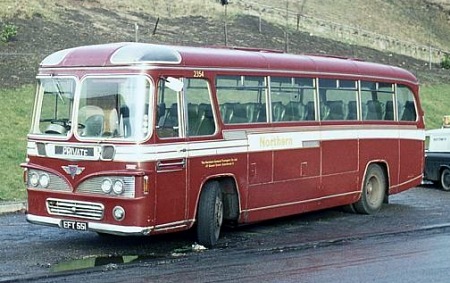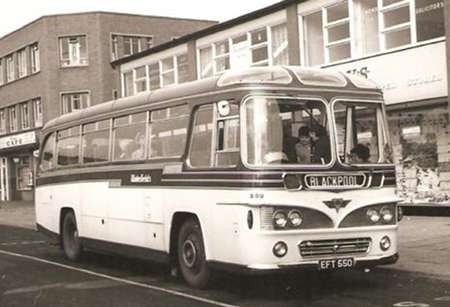
Photographer unknown – if you took this photo please go to the copyright page.
The Northern General Transport Company
1961
AEC Reliance 2MU3RV
Burlingham Seagull 70 C41F
On the subject of bus liveries that has been discussed on this site recently. Some operators seemed to adopt a one style fits all livery that hardly varied from one type of vehicle to another, and made little or no allowance for differences in body style or trim. This example from the NGT group is a rather sad looking AEC Burlingham Seagull that was once a rather attractive Wakefield’s coach number 251 based at Percy Main, the depot I worked at. Unfortunately I don’t have a picture of one of these in coach livery, but in common with most other Northern group coaches ‘except Sunderland & District’ it would have been predominantly cream with maroon window surrounds and skirt, I cant remember if the roof was cream or maroon, but they did look rather splendid. This one seems to have had some other changes made, the centre roof window above the windscreen has been removed or painted out, and the seats appear to have been changed as the originals would have been red and didn’t have grab rails fitted. Sunderland & District had some Leyland Tiger Cub’s with identical bodies and they ended up in bog standard stage carriage livery.
Photograph and Copy contributed by Ronnie Hoye
A full list of Reliance codes can be seen here.
30/10/11 – 15:02
Most regulars know that I am both an AEC and a Burlingham man. Whilst it is self evident and accepted that the original Seagull was a classic, unlike many others, I quite like the 60/70 models – even if they were not quite up to scratch with the original.
I never remember one of these in Manchester in the 70s but I only ever remember coaches in this livery, not the reversed cream version. Was the Tyne – Mersey service treated as a bus service for these purposes? This would still qualify as a quality livery by today’s standards.
One fascinating piece of trivia is that individual NGT group fleets were either AEC, Leyland or Guy fleets. So no standard corporate ordering there then.
David Oldfield
02/11/11 – 06:46
David, you are not on your own. Whilst, undeniably the Burlingham Seagull was the ‘Creme de la Creme’ I also had a soft spot for the 60/70 series.
My local operator Baddeley Bros. of Holmfirth had two original Seagulls on Royal Tiger chassis KWU 844 (1951) and LWY 653 (1953). They then had Bedford SBG/Burlingham RWY 277 in 1956, again still quite attractive. Then came four SB3’s in 1959 with the hugely curved windscreen Burlingham body (probably a coach version of the PA series Vauxhall Velox/Cresta cars of the period) Then in 1961 came Bedford SB1 2496 WY with the Burlingham 61 body. This body, I thought, suited the front engine Bedford better than the underfloor AEC/Leyland chassis. This coach was followed in 1962 by a Duple Gannet bodied SB5. Things were starting to slide Burlingham wise!
All these coaches served me as school buses between 1965/70 so perhaps I’m looking through rose tinted glasses.
I thought the 1959 petrol engined SB’s mundane, 2496 WY and it’s Gannet bodied sister 433 BWU, so-so but when we got the Royal Tigers with the classic Seagull body which was not that often, despite there age, that was the ‘Creme de la Creme’!
Eric
02/11/11 – 09:26
Couldn’t agree with you more, Eric. They were a superb coachbuilder but, towards the end, had more than their fare share of dogs – especially regarding design. Apart from the plastic roofs on Seagull 60s, I’m not aware of any considerable drop in quality and the Duple Continental and Firefly/Dragonfly were Burlinghams in everything but name and seemed to have a good reputation.
I’m a Sheffielder, who had relatives in the Barnsley and Huddersfield areas, and always thought Baddeley Brothers looked quite classy. I was only really aware of them as a student in the early 70s, passing through on the X19. By that time, the principal vehicles were Bedford YRQ/Plaxton Panorama Elite Express grant vehicles. They still looked smart, though.
David Oldfield
02/11/11 – 15:04
David, Your mention of plastic roofs on the 60’s has jogged my memory. I remember the cloth trim on the interior ceiling of both 2496 WY and 433 BWU being quite badly stained by the ingress of water when they would probably be only about five years old. Baddeley’s also had a Duple Alpine Continental on a Leopard chassis 474 EWW. Of course the other sizeable coach operator in the Huddersfield area was Hanson’s who had two batches of Firefly’s on Ford chassis in 1963/4
Eric
03/11/11 – 06:27
Strange, isn’t it, how many operators had heavy (or medium) weight service buses and lightweight coaches? Hanson and Booth and Fisher (recently posted) had AECs and Ford coaches, York Pullman was AEC/Bedford, the Doncaster indis went down a similar road and this was replicated around the country. Firms like Baddeley Bros were less common, but by no means unique, with their mix of heavy and light weight coaches.
David Oldfield
03/11/11 – 17:46
Hanson’s was rather a complex fleet in the fifties. The coaches were a mix of Regal III and Reliances and Bedfords and the buses were AEC with a smattering of Albions. Between 1956 and 1966 most of the AEC’s went on to be rebuilt as buses. The Bedfords were kept anything from 2 to about 5 years and from about 1959 all new coaches were Fords right to the demise of the Hanson business in 1974. This change of allegiance is thought to have being something to do with Hanson Haulage buying large numbers of Ford lorries.
Baddeley’s although being a smaller operator chose both Leyland and Bedford for new coaches in the fifties, many with Burlingham bodies, this policy continuing into the sixties. They also purchased quite a few secondhand coaches, including 2 that had been operated at one time or another with Hansons. Another feature of Baddeley’s was the hiring in for the summer season of coaches from local dealer Hughes and the Baddeley’s fleet name and number being applied. Several of these were in Wallace Arnold cream as the had be leased by WA for one or two seasons from Hughes when new. This led to Baddeley’s having quite an interesting and varied fleet. Wish I had owned a camera in those days.
Eric
04/11/11 – 07:04
I agree with you David. The last of what some would call ‘proper coaches’ to carry the Wakefields name were two Plaxton Embassy Bedfords ‘SB8’s I think’. The next Wakefields after that were Alexander ‘Y’ type DP’s on Leyland Leopard chassis, but I think that would have been a decision based on economics. Percy Main depot didn’t have any long distance or express routes, so the coach fleet was only used for private hires and excursions and most were de-Licensed at the end of Blackpool Illuminations, so apart from three double deckers the Wakefields name virtually disappeared from October until about Easter, where as the DP’s were used all year round and went onto stage carriage work in winter months. If memory serves, for the first couple of years some of them had the seats changed to ordinary bus type during the winter.
Ronnie Hoye
13/11/12 – 08:40
I remember going to the Lake District in the early 60s on one of these and it did indeed have the reversed coach livery the above is a later incarnation.
Malcolm Swaddle
18/04/13 – 17:40

Not in colour I’m afraid, but I’ve found this photo of one of EFT 551’s sisters in its original Wakefield’s livery. As I’ve said, Percy Main had four of these, EFT 550/3 – 250/3; and they remained in service as coaches until about 1970, they were then transferred to Northern and downgraded to D/P’s
Ronnie Hoye
Leave a Reply